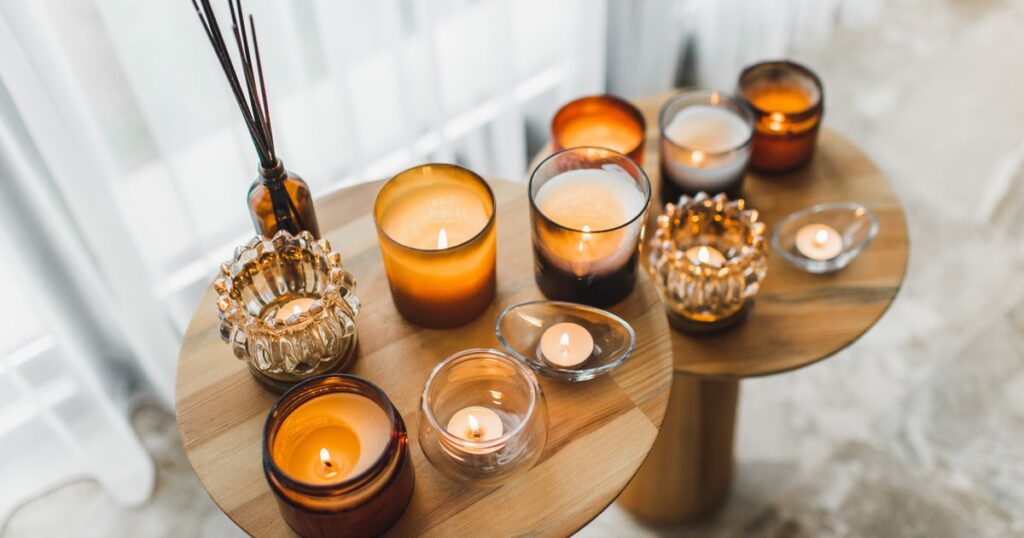Whether you regularly haul your favorite three-wicks from a major retailer or you received a hand-poured vessel as a gift, almost everyone has a scented candle in their home.
In 2023, a group of scientists claimed in a National Library of Medicine editorial that “several harmful gasses are released” when you burn scented candles, ranging from “those known to have no effect on health” to “those that may be cancerous,” exacerbating the health concerns surrounding candles.
But multiple factors play into how scented candles affect one’s health, including the type of wax and dyes used to make the product, the fabric of the wick, the candle’s fragrance and the environment in which one uses it.
“While they smell wonderful and many people find them soothing, asthmatics and COPD [chronic obstructive pulmonary disease] patients are very prone to have not just coughing fits, but exacerbations or attacks once they inhale these substances,” pulmonologist Dr. Anthony Saleh of New York-Presbyterian Brooklyn Methodist Hospital told HuffPost.
“COPD and asthma patients are the most common, but there have been a plethora of cases of normal healthy lungs going into spasm. So while they smell good and they look good, they’re not always good [for your health,” Saleh said.
Experts explain what to look for in your favorite candles if you want to minimize impacts on your health when lighting up.
How To Spot A Safe Candle Wax
When candles burn, they release volatile organic compounds (VOCs), which include a variety of chemicals, and the concentration of VOCs is up to 10 times higher indoors than outdoors. According to Saleh, the VOCs released by paraffin candles have a worse effect on one’s health than more natural alternatives like soy, coconut, palm or beeswax. While significant research has not been done on the subject, there have been some suggestions that “the paraffin [candles] may be somewhat more injurious,” Saleh said.
Dr. Ruchi Singla, who specializes in diagnosing and treating allergies and immune disorders at UChicago Medicine, agrees. “When you’re burning candles, these gases get vaporized into the air, and we’re breathing them in so they can affect our sinuses, our lungs, even our skin,” she told HuffPost. “The recommendation is now to try to use candles that are made more naturally, either from soy wax, beeswax, steering to coconut oil or animal fat-based ingredients. That might be healthier.”
Retailers often opt for paraffin over the more natural alternatives due to cost. “Paraffin is cheaper,” synthetic organic chemist Dr. Nada Khan told HuffPost. “As you go more clean, they’re more expensive.”
What To Avoid In Candle Fragrances
Customers typically buy a candle for its scent, but just as natural waxes prove to be the better-for-you choice, so do naturally occurring essential oils.
“Steer toward the more natural ingredients and the ones that rely less on the artificial fragrances and dyes,” Singla advised.
Khan shared that when she buys candles, “I don’t read the label in detail, I just see the natural products and the synthetic ones. The natural ones, they have essential oils. They’re safe, but sometimes an individual has an allergy to a specific natural one.”
That can be due to the concentration of the fragrance used in the candle, which Jefferson Health allergist Dr. Elina M. Toskala said can cause congestion, a runny nose and/or headaches.
“There’s something about the strong smells that can trigger a quite strong reaction in our airways,” she told HuffPost. “The upper airway takes it first, but the upper airway can activate the lower airway hyperreactivity and can make you cough. Very sensitive patients with asthma can feel chest tightness and even wheezing. The milder the smell, I would think there’s less of that chemical in the candle.”
Ultimately, you want to avoid phthalates in your scented candles, which are chemicals used to retain the scents in fragrances — like preservatives for candles. Phthalates often appear as acronyms such as DEP (diethyl phthalate), DnHP (di-n-hexyl phthalate, known for causing headaches) and DIDP (diisodecyl phthalate, which often worsens asthma and allergy symptoms).
“With toxicology, our mantra is the dose makes the poison,” inhalation toxicologist Dr. L. Cody Smith told HuffPost. “So the dose that you are getting from the scented candles of these potential toxic byproducts would be a factor.”
Given the little regulation around candle labeling, retailers don’t have to list the exact ingredients — and therefore disclose any phthalates — in their products. “Hopefully, there’ll be more research and better labeling around these things so that we can make those more informed decisions,” Singla expressed.
The Potentially Cancerous Chemical In Candle Dyes
Singla recommended opting for more natural dyes, too. “There aren’t a ton, but that might be a better option than the artificial ones or the synthetic ones,” she said.
That’s because artificial dyes sometimes use benzine. “The derivative of benzine itself is carcinogen, which means it causes cancer in the long term, not right away,” Shah said. “The derivative is sometimes present in the dyes, so these days, people are going towards natural dyes and colorant.”
“When we burn candles, scented or unscented, we are generating chemicals into the indoor air environment that we do inhale, and these chemicals could be products from the wax, the fragrances or even the wick,” Smith said.
Given all the options out there, the experts say you don’t have to ditch scented candles entirely.
“By no means am I saying nobody should use scented candles,” Saleh stated. “Much like many things with lung health, common sense, knowing your limitations and knowing what your conditions are, go a long way. Everything in moderation.”
Toskala called it a “trial and error” process to figure out which scented candles your body can handle. “People might be able to tolerate some smells but not others,” she said, adding that “there’s potentially a lot of good things like emotional effects from these candles. And they look nice!”
Singla feels similarly. “Trying to make educated decisions on choosing the better options makes sense,” she said. “But if burning a candle once in a while makes you calm and improves your mood, I think there are some other benefits that we might be ignoring.”
Read the full article here








